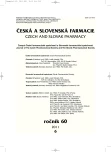Medicinal preparations in this country at the end of the 18th century
Part II – Semisolid and solid dosage forms
Authors:
Pavel Drábek
Published in:
Čes. slov. Farm., 2011; 60, 296-302
Category:
History of Pharmacy
Overview
This paper links up with Part I and deals with the other medicinal preparations, which were originally included in the Austrian book of prescriptions Dispensatorium pharmaceuticum Viennense and then taken over to the Austrian provincial pharmacopoeia Pharmacopoea austriaco-provincialis, repeatedly published between 1774 and 1794. This part discusses semisolid dosage forms, e.g. Electuaria, Mella, Pulpae, Unguenta, and solid dosage forms, e.g. Emplastra, Extracta, Morsulae, Pilulae, Pulveres, Rotulae, Tabulae, Trochisci. The final part of the paper also lists chemical substances (Chymica et consimilia) prepared in pharmacies and presents general evaluation of the provincial Pharmacopoeia.
Key words:
pharmaceutical technology – Dispensatorium pharmaceuticum Vienense – Pharmacopoea austriaco-provincialis – Taxa medicamentorum
Sources
1. Dispensatorium pharmaceuticum Austriaco-Viennense…Viennae Austriae MDCXXIX. Reimpressum MDCCLI.
2. Pharmacopoea Austriaco-provincialis, Viennae MDCCLXXV.
3. Pharmacopoea Austriaco-provincialis emendata,. Viennae 1794.
4. Taxa medicamentorum in Pharmacopoea Austriaco-Provincialis emendata … Prag 1796 (Národní knihovna v Praze, sign. 65 E 4348).
5. Taxa medicamentorum in Pharmacopoea Provinciali contentorum … Prag 1819
6. Hladík, J., Fundárek, R.: Vývoj technologie pilulek v českých zemích a na Slovensku, Z dejín vied a techniky na Slovensku I. Bratislava: Vydavatelstvo SAV 1962; 167–200.
7. Drábek, P.: Léčivé přípravky v Obnoveném pražském dispensatoriu z roku 1750. Čes. slov. Farm., 2010; 59, 234–240.
8. Německý chemik a lékař Georg Ernst Stahl (1660–1734) byl profesorem na univerzitě v Halle.
9. Diaforetiky se nazývaly látky podporující pocení.
10. Pejml, K.: Dějiny antimonu se zvláštním zřetelem k lékárnictví. Časopis českého lékárnictva 1941; 21, 106–111, 125–130, 142–146.
11. Švédský lékař a biolog Carl Linné (1707–1778), zakladatel vědeckého systému rostlin a živočichů.
12. Lékař Theodor Birkmann působil v Kolíně nad Rýnem a byl spoluautorem tamního dispensatoria z roku 1565.
13. Německý lékař Johannes Crato von Crafftheim byl osobním lékařem císařů Ferdinanda I., Maxmiliána II. a Rudolfa II.
14. Německý chemik Johann Rudolf Glauber (1603–1670) byl autorem četných spisů o chemických léčivech.
15. Řecký lékař Rufus z Efesu (2. stol. n.l.), jemuž je přisuzováno autorství pilulek proti moru.
16. Francouzský lékárník Pierre Seignette (1660–1719) připravil se svým bratrem vínan sodno-draselný (Sal polychrestum).
17. Hladík, J.: Z domácí lékopisné tradice. Farm. Obzor 1963; 30, 8–14.
18. Künzler, U.: Die Arzneimittel der Familie Mozart. Geschichte d. Pharmazie, 1998; 50, 12–19.
19. Ganzinger, K.: Die österreichische Provinzial-Pharmakopöe (1774–1794) und ihre Bearbeiter. Zur Geschichte der Pharmazie, 1962; 14, 17–24.
Labels
Pharmacy Clinical pharmacologyArticle was published in
Czech and Slovak Pharmacy

2011 Issue 6
Most read in this issue
- On the question of special over-the-counter drugs
-
Medicinal preparations in this country at the end of the 18th century
Part II – Semisolid and solid dosage forms - Clinical significance of cytochrome P450 genetic polymorphism – part IV. Cytochrome P450 3A4 and 3A5
-
Study of local anesthetics – Part 195
Study of micellization of pentacainium chloride in methanol and ethanol solutions
